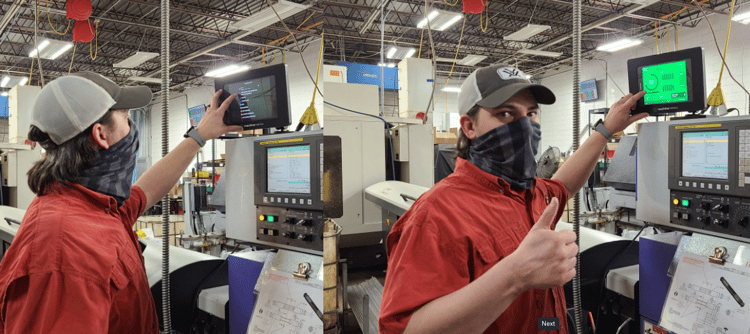Key Takeaways:
- Tooling costs are a significant expense in manufacturing, impacting overall production costs.
- Optimizing tooling usage and extending tool life can lead to substantial cost savings.
- Regular maintenance and proper tool management are key strategies for controlling tooling costs.
With labor, transportation, and material costs rising in every manufacturing sector, companies are anxious to find ways to save money. For CNC machining, tooling is an additional, often unforeseen, cost that must be incurred as a part of the business.
Developing a better understanding of the factors that play a part in tooling costs as well as learning how you can track the health of tools will help to manage a healthier bottom line. This guide explores the factors that impact tooling costs and the benefits associated with measuring this expense item.
What is Tooling Cost?
Tooling Costs represent the depreciated tooling price over the life of the tool divided by the number of parts that were made during the life of the tool. It is a difficult measurement to monitor, but with a solution to understand tool life, manufacturers can get deeper insight into the performance and cost of their tooling.
Why is Tooling Important? Isn't it a Minor Cost?
Tooling cost consideration is important because the quality and condition of tooling will dictate the quality of the finished part.
The precision and performance characteristics of a tool will determine the speed and precision of finished parts. It will also ensure repeatability in manufacturing and the accuracy of each piece coming off the line. The tooling process isn’t a matter of "lowest cost" sourcing. The tool's design must be considered along with other variables, including the type and volume of parts produced and the hardness of the material.
Choosing a tool that is too hard for the type of part produced may result in quality defects and higher costs. Choosing a tool that isn’t hard enough for the workpieces machined will mean that tools wear or break more quickly.
Tooling costs will ofcourse differ between different types of operations - but within most it will be ideal to maximize tool life without incurring costly tool failures and the resulting scrap parts. solutions like Tool Anomaly Detection can help pinpoint this timing to ensure the highest ROI on tooling.
| Reducing Tooling Costs: BC Machining had been experiencing excessive tool breakage in their Swiss CNC machines, creating scrap both at the point of breakage and near-end-of-tool-life when parts can vary out of spec. Using MachineMetrics, BC was able to identify tool breakages to prevent scrap parts. Read the full story. |
What Should Tooling Cost?
Tooling costs will depend on the type of product made. Company tooling costs may run as low as 3% or as high as 6% of top-line costs. Because all tooling must eventually be replaced, tools are generally considered consumables.
Suppose a company makes volume precision units for each customer and has small parts in its product mix. In that case, tooling cost can be accurately predicted through analysis of use over time.
However, suppose the company produces many parts or does numerous custom parts in volume or as one-offs for each customer. In that case, they’ll need to carry a more extensive inventory of tools to account for different variables such as blank material.
What Factors Impact the Cost of Tooling?
While many factors impact tooling costs, they’re all related to the type of material being worked, the number of actions required by part specifications, and the quality of the tool.
Material
Industries such as medical, aerospace, and defense have extremely tight requirements for high-strength parts. Materials such as hardened steel, titanium, and others will require tools with a higher hardness to perform cuts. These tools are understandably more expensive than those used to cut, bore, or finish materials with less hardness.
Part Specification
The number of actions the CNC machine must take also impact the cost of tooling. Simple cuts or bores require fewer tools. Intricate cuts, bores, and turning will need more tools. The parts may also require specific surface finishes such as polishing or adding features that can be gripped by other tools or coverings such as gaskets. Each additional step in the design specifications will increase tooling costs.
Quality of Tools
Tools should be sourced from suppliers with a deep knowledge of the performance characteristics of surfaces to be cut. They must be produced with exact manufacturing process specifications that ensure the proper temper and heat treatment to prevent fast dulling or brittleness. Tools should also be well matched to the machine used to avoid mismatched force, speed, or capability.
The Benefits of Tooling Cost Measurement
Measuring tool life allows tooling cost measurements to be more accurate. Using a machinability calculation for tool life that compares material properties relative to tool characteristics means a company can develop charts or algorithms for purchase amounts, types, and lifespans.
Other methods include force and power measurement of the equipment and taking the machinability rating for the material into account.
There are several benefits to tool cost measurement, including:
- Reducing Material Costs: Measuring the cost of different types of tooling can result in lower material costs. High-quality tooling may cost more on the top-line, but if their lifespan is longer and they incur less breakage, companies can realize fewer scrap outs and less waste.
- Evaluating Production Processes: Tool quality directly affects the equipment it’s used in and challenges the operator's skill. It’s not uncommon for the capabilities of a machine or operator to be called into question. Tool cost measurement can lead to a better understanding of power consumption, the force used, and other variables that allow process changes.
- Design Changes: By measuring tool costs, design flaws can be uncovered to improve quality assurance. Changes may be as simple as a reorientation of the part or as complex as changing the number of cuts. With an understanding of tool costs, decision-makers can gain insight into what changes to suggest to deliver the highest quality part.
- Reducing Energy Costs: High speed and strong force are high energy variables. With an understanding of tool cost, managers can analyze energy to breakage to source tools that can handle these elements better.
Maximize tool life and eliminate scrap
How Can You Maximize Your Investment in Tooling? [Case Study]
When BC Machining sought help to address continuing tool breakage and high scrap rates, they engaged MachineMetrics for a solution. BC Machining serves the medical, defense, transportation, and power tool industries where precision is critical.
BC Machining had been experiencing excessive tool breakage in their Swiss CNC machines, creating scrap both at the point of breakage and near-end-of-tool-life when parts can vary out of spec.
Using the MachineMetrics solution of capturing high-frequency data and analyzing it through advanced algorithms, BC was able to identify tool breakages to prevent scrap parts.
The drop in lost parts, sorting, and uncertainty translated into near 100% failure detection and a $72,000 annual savings per machine.
Read the complete case study with BC Machining.

MachineMetrics offers a monitoring system for tool assessment that collects data directly from the source – the CNC machine itself. Through custom algorithms designed to monitor torque usage, inputs can be entered into the system as time-series events or machine learning models to predict tool failure accurately.
MachineMetrics' high-frequency data adapter can detect the problems and analyze the data at the edge to automate solutions and alert staff to issues before the failure occurs, preventing costly scrap and downtime. With advanced machine diagnostics, tooling is optimized and incorporated into an aggressive and fully automated predictive maintenance system. To see how MachineMetrics can be deployed to help you get a handle on your tool's health needs, book a demo with our team today.
Want to See the Platform in Action?


.png?width=1960&height=1300&name=01_comp_Downtime-%26-Quality_laptop%20(1).png)



.gif)









Comments